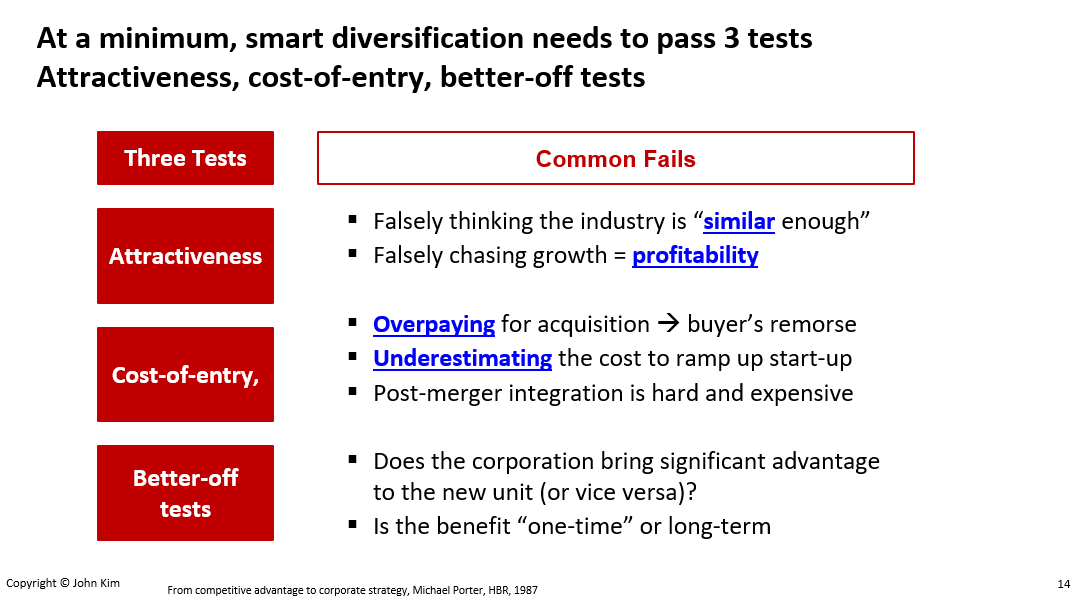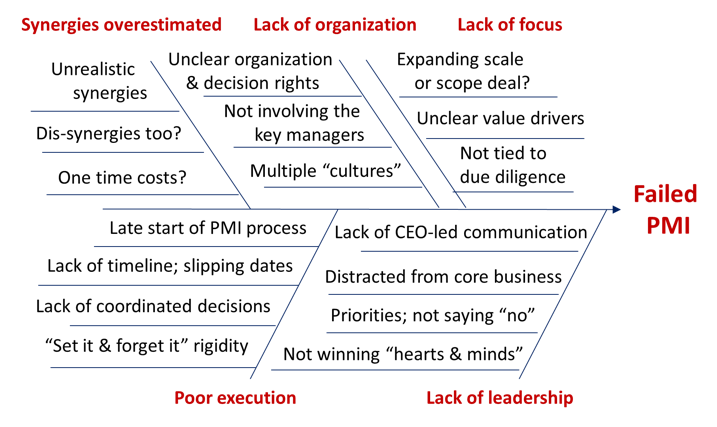This 21 letter hyphenated-phrase generates $billions of management consulting work. With M&A booming the last few years, it’s no surprise that companies need lots of post-deal support. Whether a company hire outsiders to help or not, post-merger integration (PMI) is needed with every part of the business. Yes, every part – sales, marketing, finance, IT, HR, manufacturing etc.
If you think of a corporate merger as a marriage, then you can see that there is still as lot of work left to do after the wedding date (day 1). Yes, it’s the day-in/day-out effort of the marriage that takes patience, thoughtfulness, and tends to get messy. Compared to a marriage, the wedding is easy.
Pre-deal: before the wedding
Of course, lots happens before the deal. Investment banking pitches, due diligence, valuations, clean teams and legal work. This is when the existential / strategic questions get asked:
- How will this deal help our strategic position?
- What is binding together this combination of businesses?
- Are we acquiring this company for the right reasons?
- Are we over-paying for the target company?
- Do we have the culture, commitment, patience to make this work?
Three tests of diversification
Michael Porter – yes, famous strategy professor – talks about the 3 ways that companies often mistakenly think that a merger makes sense:
Attractiveness: Are we fooling ourselves, thinking this is similar to what we already do? Are we acquiring the new company in simple search for diversified growth (read: bad idea). Have we really thought about building this capability internally? Can we not just outsource or pay money to borrow these skills on a project-by-project basis?
Cost of entry: How is the pricing? Sure, we have bankers showing us the terminal value and DCF models, but where is the industry headed? Are we paying in cash or debt? Where are interest rates? Is this a financial purchase or something more strategic
Better off test: Is this helping our competitive position? Do we have economies of scale or scope? How can we look back 3 years from now and say, “That was a genius move.” Does this increase our economic moat?

Post-deal: you gotta make the marriage work.
During the engagement and wedding, a lot of promises are made to board of directors, customers, and shareholders. The market eagerly wants to see if the whole is greater than the sum of the parts. Is 1 + 1 greater than 2? If so, prove it.
Synergies. This is a fancy M&A way of saying “benefits” of being a combined company. Generally, they come in two flavors: revenue and costs synergies.
Revenue synergies are typically harder to come across and more long-term in nature. Deloitte even called them “the holy grail” of acquisitions in this white paper here; hinting at how elusive they can be. Examples include:
- Cross-selling a wider portfolio of products and services
- Increasing pricing because of higher willingness-to-pay from customers
- Access wider group of customers for complementary products
Note: bankers and lenders look at revenue synergies with a pound of salt. They are often considered “not bankable, because frankly, who knows if customers will agree with your increased pricing and cross-selling. You have very little control over customers and competitors.
Cost synergies are the main event because there will always be some duplication / redundancy of effort which can be reduced. This can take the form of consolidated processes, reduced investment, vendor rationalization, consolidated manufacturing and personnel layoffs. These savings are estimated long before the deal takes place and tracked rigorously throughout the “marriage”.
Almost everything needs some degree of integration, and this takes guts. Tons of best (common) practices outlined in the following documents:
- Bain: 10 Steps to Successful M&A integration (760K pdf, 12 pg)
- PWC: 7 Fundamental Tenants of Successful Integration (466K pdf, 8pg)
- BCG: 6 Essentials for Achieving Post-merger Synergies (810K pdf, 19 pg)
- BCG: Post-merger Rejuvenation (851K pdf, 10 pg)
- McKinsey: Where Mergers go Wrong
What typically goes wrong?
M&A gets a bad reputation because more than half of the deals tend to destroy shareholder value. If that’s true, what usually goes wrong? Yes, sometimes the deal was poorly conceived, or the buyer paid too much. Yes, sometimes the expectations were too high. Here is my take on the root-causes of failed post-merger integration. Happy to add more to the chart – what else have you seen?

Portfolio companies may be an exception
Think of Berkshire Hathaway. This legendary portfolio company led by Warren Buffet has 60+ companies which are in a variety of (often unrelated) businesses. There are only limited synergies between Sees Candies, Geico, and Dairy Queen. They are buying these companies with the intention of keeping them separate. The look for 1) companies with an economic moat 2) strong cash flow 3) management that stays in place.
The one way they do have synergy is the large insurance float ($$ collected in premiums before they are paid out in claims). Berkshire Hathaway uses the $$ war chest created from Geico, and General RE to fund acquisitions and investments.
What do PMI projects look like?
From my experience:
- Projects tend to have multiple teams (remember, PMI touches almost all business processes)
- A project management office (PMO) keeps all the planes in flight, logistics smooth, and coordinated communication with the client
- The work is highly structured with clear templates and approaches to be used by all workstreams. Need for PMO to easily “roll up” the results
- Expect to bump-into other consulting firms while on site
- Clients counterparts (understandably) get nervous because they know that one of the key cost synergies is often layoffs
- Projects are usually longer than strategy or business case-oriented studies because this involves lots of implementation
- Can be satisfying work because you see the results of your work
- Larger teams = great team dinners and occasional “events”

excellent PMI overview. how about a 7 letter unhyphenated word that is more common: remorse!!
So funny, so true.
Great post. I passed by a PMI in 2016 (between two e-commerces retails in Brazil) and it was possible to learn a lot from the project.
Great. Thanks for reading.